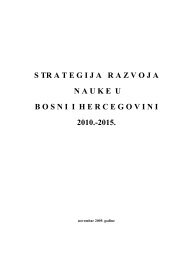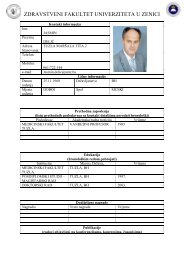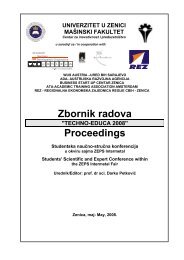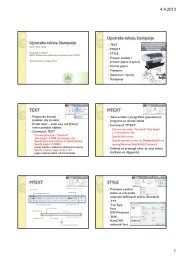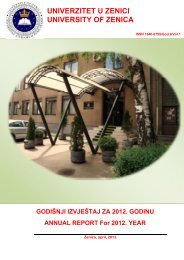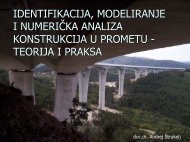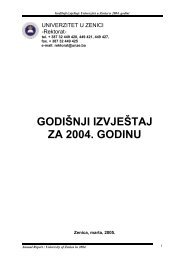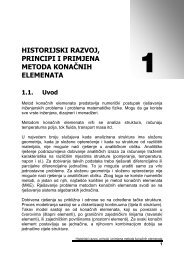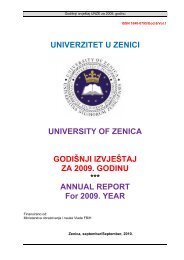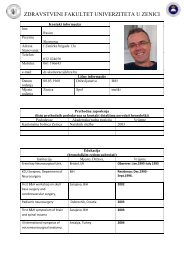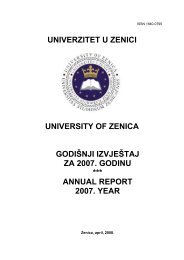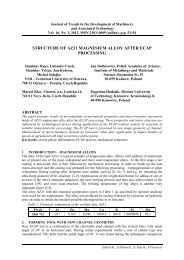vibration of rail vehicles and modelling of system by using matlab
vibration of rail vehicles and modelling of system by using matlab
vibration of rail vehicles and modelling of system by using matlab
- No tags were found...
You also want an ePaper? Increase the reach of your titles
YUMPU automatically turns print PDFs into web optimized ePapers that Google loves.
3.1. Six Degrees <strong>of</strong> Freedom Rail Vehicle ModelBased on the model given in figure 3, m g is the car body mass, m b is the bogie mass <strong>and</strong> m a is the axlemass, J g is the car body inertia, J b is the bogie inertia <strong>and</strong> J a is the axle inertia.kes 1 , kes 2 , c 1 <strong>and</strong> c 2 arethe secondary suspension stiffness <strong>and</strong> damping coefficients <strong>and</strong> k 1 , k 2 , c 3 <strong>and</strong> c 4 are the primarysuspension stiffness <strong>and</strong> damping coefficients. kh 1 , kh 2 , are the Hertzian spring stiffness.The <strong>rail</strong> vehicle model has six degrees <strong>of</strong> freedom; Z g , Z b , Z a , ø g , ø b , ø a . Z g is the vertical movement <strong>of</strong>car body, Z b is the vertical movement <strong>of</strong> bogie <strong>and</strong> Z a is the vertical movement <strong>of</strong> axle. θ g , θ b , θ a are theyaw movement <strong>of</strong> car body, bogie <strong>and</strong> axle respectively. Zy 1 <strong>and</strong> Zy 2 are the irregularities on the track<strong>and</strong> regarded as a sinus function [6].L 12L 2Z az gkes 1m g , J gc 1 c 2m b , J bθ bθ gz bkes 2kh 2c 3 k 2k1 c 4m a , J a θ a, k akh 1z y1z y2Figure 3. Quarter <strong>rail</strong> vehicle model[6].The equations <strong>of</strong> motion <strong>of</strong> the <strong>rail</strong> vehicle are obtained <strong>by</strong> the use <strong>of</strong> the Lagrange Equation. Theequation <strong>of</strong> motion <strong>of</strong> the <strong>rail</strong> vehicle <strong>system</strong> is:[ M ]& z&+ [ C] z&+[ K] z = Fz(8)[M], [C] <strong>and</strong> [K] are mass, damping <strong>and</strong> stiffness matrices <strong>and</strong> [Fz] is the force resulting trackirregularity motion.4. MATLAB/SIMULINKSimulink able setting up dynamic <strong>system</strong> models <strong>by</strong> <strong>using</strong> block diagrams. So it is possible to examinethe <strong>system</strong>s as in a laboratory. The equations <strong>of</strong> motion obtained from the former part are given in theMATLAB form in equations (9)-(14):(-1/mg)*(kes1*((u[1]-u[3])-L1*u[7])+kes2*((u[1]-u[3])+L1*u[7])+c1*((u[2]-u[4])-L1*u[8])+c2*((u[2]-u[4])+L1*u[8])) (9)(-1/mb)*(-kes1*((u[1]-u[3])-L1*u[7])-kes2*((u[1]-u[3])+L1*u[7])+k1*((u[3]-u[5])-L1*u[9])+k2*((u[3]-u[5])+L1*u[9])-c1*((u[2]-u[4])-L1*u[8])-c2*((u[2]-u[4])+L1*u[8])+c3*((u[4]-u[6])-L1*u[10])+c4*((u[4]-u[6])+L1*u[10])) (10)(-1/ma)*(-k1*((u[3]-u[5])-L1*u[9])-k2*((u[3]-u[5])+L1*u[9])+kh1*((u[5]-u[13])-L2*u[11])+kh2*((u[5]-u[14])+L2*u[11])-c3*((u[4]-u[6])-L1*u[10])-c4*((u[4]-u[6])+L1*u[10])) (11)(-1/Jg)*(-kes1*L1*((u[1]-u[3])-L1*u[7])+kes2*L1*((u[1]-u[3])+L1*u[7]) -c1*L1*((u[2]-u[4])-L1*u[8])+c2*L1*((u[2]-u[4])+L1*u[8])) (12)827
(-1/Jb)*(-k1*L1*((u[3]-u[5])-L1*u[9])+k2*L1*((u[3]-u[5])+L1*u[9]) -c3*L1*((u[4]-u[6])-L1*u[10])+c4*L1*((u[4]-u[6])+L1*u[10])) (13)(-1/Ja)*(-kh1*L2*((u[5]-u[13])-L2*u[11])+kh2*L2*((u[5]-u[14])+L2*u[11])) (14)These equations (9)-(14) are written in the boxes named as vertical motion <strong>of</strong> car body, bogie <strong>and</strong>axle(wheelset) <strong>and</strong> yaw <strong>of</strong> car body, bogie <strong>and</strong> axle (wheelset) respectively. And then, with the help <strong>of</strong>m.file it is possible to realize the simulations for asked parameters.4.1. Create a Model in SimulinkFigure 4. Simulink block diagram <strong>of</strong> quarter <strong>rail</strong> vehicle model.5. RESULTSThe application <strong>of</strong> the MATLAB as environment gives us a chance to build a user friendly interface<strong>and</strong> <strong>using</strong> the possibilities <strong>of</strong> the MATLAB/Simulink made the package open for inserting new options<strong>by</strong> the user as well as decreasing the time <strong>of</strong> preparing <strong>and</strong> carrying out the simulation process. In thelight <strong>of</strong> this paper it is possible to obtain motion equations for all degrees <strong>of</strong> freedom <strong>system</strong>s <strong>and</strong> torealize the simulation in MATLAB/Simulink.6. REFERENCES[1] Chudzikiewicz A.: Simulation <strong>of</strong> Rail Vehicle Dynamics in MATLAB Environment, Vehicle SystemDynamics, 33, pp. 107-119, 2000,[2] Esveld, C.: Modern Railway Track, MRT Productions, 2001,[3] Knothe, K.: Gleisdynamik, Technische Universitat,2001,[4] Jenkins, H., Stephenson, J., Clayton, G.A., Morl<strong>and</strong>, G.W., Lylon, D.,: The effect <strong>of</strong> track <strong>and</strong> vehicleparameters on Wheel/<strong>rail</strong> vertical dynamic forces, Railway engineering Journal, 2-16, 1974,[5] Yalcin, N.S., Guclu, R., Metin, M., Yazici, H.: Analyses <strong>of</strong> <strong>rail</strong>way induced <strong>vibration</strong>s for different tracktypes, Inter-Noise 2007, İstanbul, Turkey.[6] Bayraktar, M., Guclu, R., Metin, M., Yazici, H.: Vibration Analysis <strong>of</strong> Light Rail Vehicle Due to AxleModelling, UMTS 2009, KKTC.828



